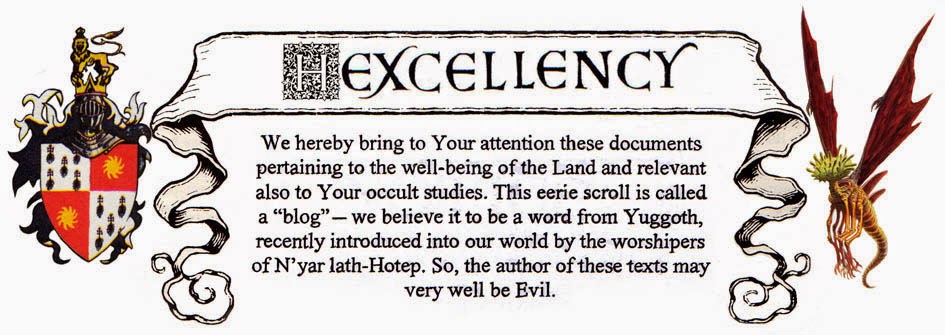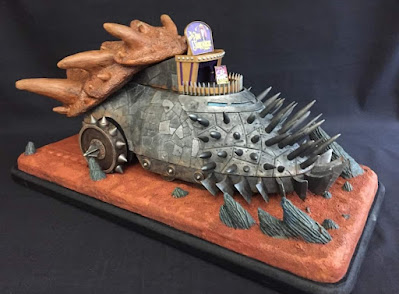Don’t worry: this post isn’t political.
It’s a reflection on which in-game means belong to one character alone, and which resources belong to the entire party or group. In some instances, said question can be annoyingly and surprisingly problematic.
To demonstrate, I’m going to talk about the amazing game my friend Jean-Pierre has been running since the early nineties. Bear with me for a while, ladies and gentlemen, and you’ll see exactly what kind of pickle I’m alluding to.
Jean-Pierre’s game is a genuine homebrew world with its own original mechanics, stats, proficiencies, and magic system. We also get something called “Dragon Points,” possibly the most valuable resource in the game. Dragon Points are not like Fate Points in Warhammer — they are not “spare lives” for your character, video game style. (“I’m fresh out of Fate Points; the next time I die, I die for good.”) Rather, Dragon Points are like Anything Points, in that you can spend one — or more — at any given moment, to secure those additional arrows your character forgot to buy while passing through town, or to ensure that the sacred scroll he or she is carrying miraculously didn’t get wet when a tidal wave swept the coastal village, or to add a number of successes to an important To Hit roll or ability check. Dragon Points allow you to intercede directly, like if you were to become your own Dungeon Master for just a second...
As the party is waiting outside the throne room, they happen to hear some other guest mention that Her Majesty the Queen absolutely LOVES a rare wine from Ullendale. Your character can choose to spend a Dragon Point to actually have a bottle of Ullendale wine in his or her pack. When the party is finally allowed entry to the throne room, the Queen’s mood immediately lightens as she is presented with such a thoughtful gift.
You only earn a Dragon Point when your character does something formidable, heroic, or truly hilarious. They’re hard to come by.
Around Christmas time, two years ago, Jean-Pierre sent an email to all his players. It was a quiz — five increasingly difficult, in-universe questions about his game world, with a total of 15 Dragon Points to win, per player!
Personally, I have been jotting down notes and sketching cool NPCs and redrawing city maps in my little notebooks for over twenty years, so I got four out of five questions right, for a total of 12 Dragon Points. No other player approached that in the quiz. One player didn’t even bother to answer the email, not because he’s a bad player, not at all, but he knows he isn’t good at remembering weird fantasy names and fictional places.
So now my character, Stygia Steve, has a huge pool of 12 Dragon Points. I’ve never had so much of that precious asset in all my years playing in this game.
First time we get together and play since the pandemic began, our party finds itself into an especially nasty fight with an unkillable samurai zombie and a tough Dwarf zombie, plus a couple undead wolves — and our big plate-mail-clad 17th-level tank is rapidly dropped to 3 HP. Fuck…
We don’t have a healer per se, so the monk tries his very best at first aid, and my character decides to use the free-form magic system to conjure up some degree of healing, but it is costly, very costly indeed; I’m gonna have to roll at least 30 on my 3d12. Almost impossible.
“What if I spend a Dragon Point on that roll?” I ask.
“You add 10 to your result,” Jean-Pierre says.
“I’ll do it.”
I roll 3d12, and get 6, 4, and 2. Plus 10 for the Dragon Point, it’s a total of 22, and I needed 30 for that spell to take effect. I wasted a Dragon Point, damn it.
We need our tank to get through this accursed place — so I try again, and this time, I spend 2 Dragon Points, adding 20 to my roll. The roll succeeds. Our tank regains 30 Hit Points, putting him at 33, but it is still an awfully long way from his max HP.
So, guess what? I do it again. Two more Dragon Points, and another 30 Hit Points healed.
The big guy is at 63 HP now. It is safe to continue the adventure, right?
*
Stygia Steve has 7 Dragon Points left, and the adventure is not over yet. What happens after the next nasty fight? Everyone will pressure me to “heal” the tank, even though healing spells are not my character’s specialty…
I’ll be able to burn another 6 Dragon Points for three 30-HP healing surges, and then attempt a fourth and last one with 1 Dragon Point… and then…
What is the worst thing that could happen?
You can almost see it, don’t you?
My character could eventually find himself in a situation where he must make a very important dodge to avoid falling into an acid pit; 26 to succeed, 16 on the roll, and if he had a Dragon Point in his sleeve, he could push that roll to 26 and make it by the skin of his teeth.
Or, he could be hanging off a cliff, while the other characters are either down or busy fighting several opponents some fifty feet away. No helping hand available for Stygia Steve; he loses his grip, and falls to his death. If he’d had at least 1 Dragon Point, I could have said, “I spend a Dragon Point and there’s a long, gnarled root not ten feet beneath me — and I try to grab on to it…”
But I don’t have any Dragon Points left.
So I die.
It’s hypothetical. But still a head-scratcher.
One player takes comprehensive notes for years and years, draws sketches, memorizes the names of kingdoms and cities and rivers and remote mountain ranges, and then, one day, it pays off. Boom: 12 Dragon Points!
The party’s tank alone is going to benefit from that.
Might seem wildly unfair, sure, but the tank protects you and everybody else in that party, doesn’t he?
Yes he does. He is always right between us and danger.
So where’s the problem?
It’s a conundrum; sooner or later, somebody’s going to die for lack of a spare Dragon Point — and it might very well be the one guy who had all the Dragon Points to begin with.
Am I entitled to keep at least 1 Dragon Point in my sleeve, you know, just in case? In other words, what resources are mine and mine alone?
I remember seeing this in the early eighties: the paladin is at 2 HP, and the thief (there were no rogues back then) is the only one in the group with a potion of healing… and he refuses to “waste it” on the paladin. Different times. We were way more selfish.
Now that we live in a sharing economy, naturally, we share resources. Your character found a potion of extra-healing during a solo game last weekend? That potion is still going to benefit the next character in your party who ends up in dire need of healing, whoever he or she may be. And yes: when comes your character’s turn to be in dire need of healing, there might not be any healing resources left in the party’s pool.
Here’s one easy solution. If you create a quiz to reward those players who take abundant notes, the rewards should be ability improvements and / or single-use powers.
Question 1. Difficulty: average. Reward: add +20 damage to any melee attack your character makes. One use only.
Question 2. Difficulty: hard. Reward: increase your character’s Constitution by 1, permanently.
Question 3. Difficulty: very hard. Reward: even if your character isn’t a spellcaster, he or she gains the ability to regenerate 1d20 Hit Points, 25 times (3/day max). Self only.
See what I mean?
While we’re here, let’s broaden the scope of this rumination. Why not replace most magic items with innate character abilities? It’ll only prevent preposterous min/maxing shenanigans. I have seen players transfer all useful items and amulets and bracers and rings to one Dwarf fighter, and then this super-buffed character entered the boss’ lair alone, and fought the entire combat all by himself, while the rest of the party cowered in the corridor, “feeling naked.” And this wasn’t in the eighties, mind you; it was four years ago.
Not fun tabletop role-playing. Again, video game mindset.
The ultra-selfish players of 1983 look pretty good now, don’t they?
Three words: Innate personal powers.
And it works wonders on NPCs, too. Instead of giving Fingon the Elf a +3 longsword, give him an added +3 proficiency bonus, and the innate ability to hit creatures that can only be hit by magical weapons. It’s much better. The bonus lives inside that NPC instead of in a blade that can — and will — be stolen from him at the very first occasion.
I’m not mad because of the Dragon Points thing. If I burn them all to heal our party’s tank, so be it. And later, if good ol’ Stygia Steve croaks because he doesn’t have any Dragon Points left — so be it. But it’s a thought-provoking prospect, and writing an article on this topic seemed like a worthy idea.
We’re due to play our next game in three weeks. Literally anything can happen. And I shall write about it right here. Of course.
I’ll share.










